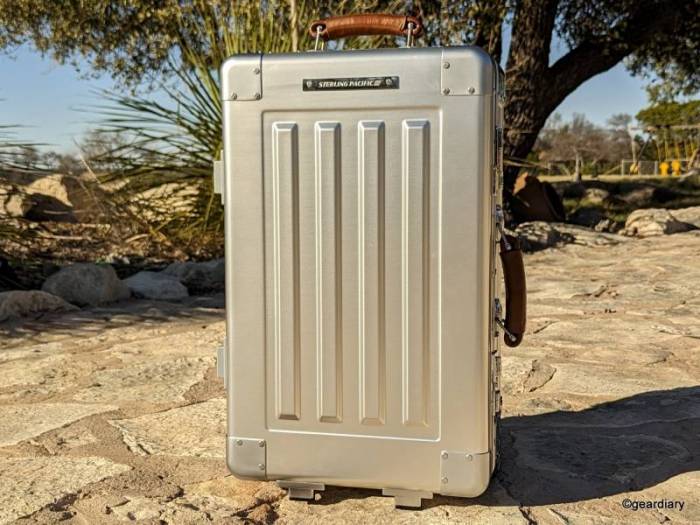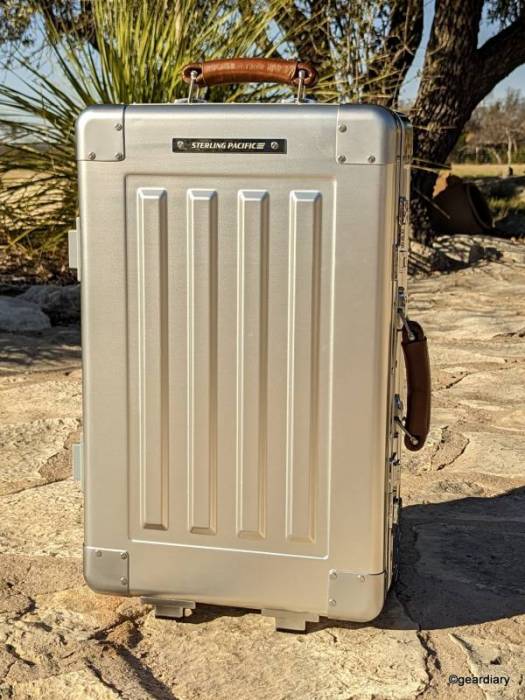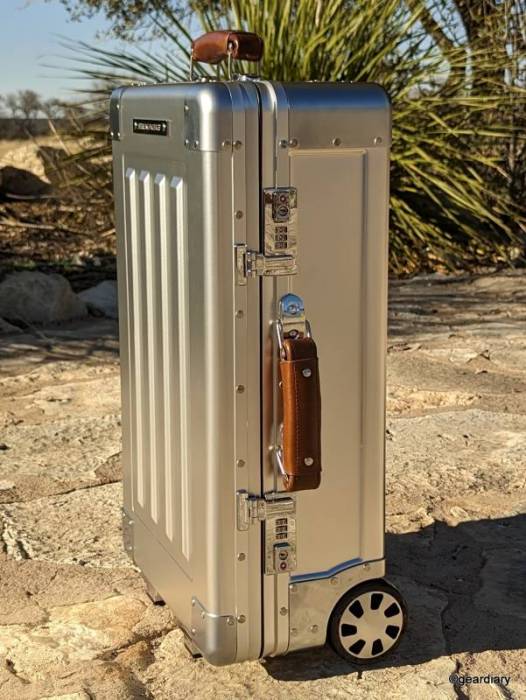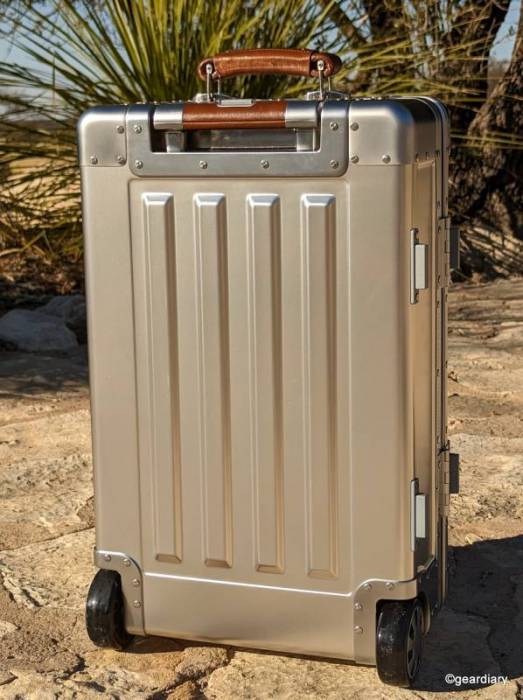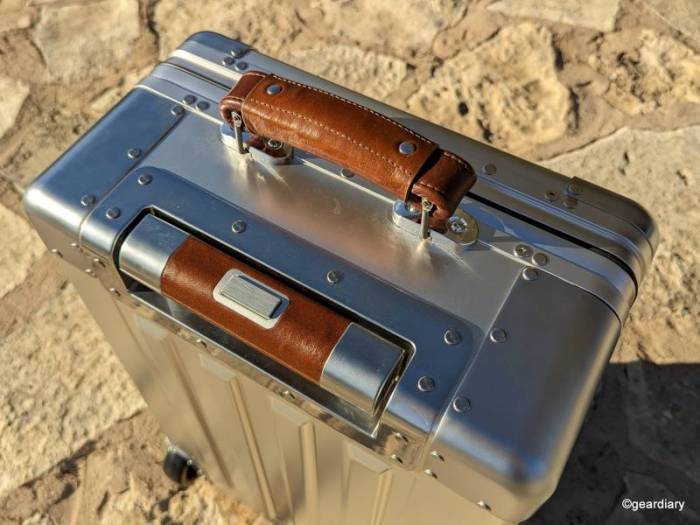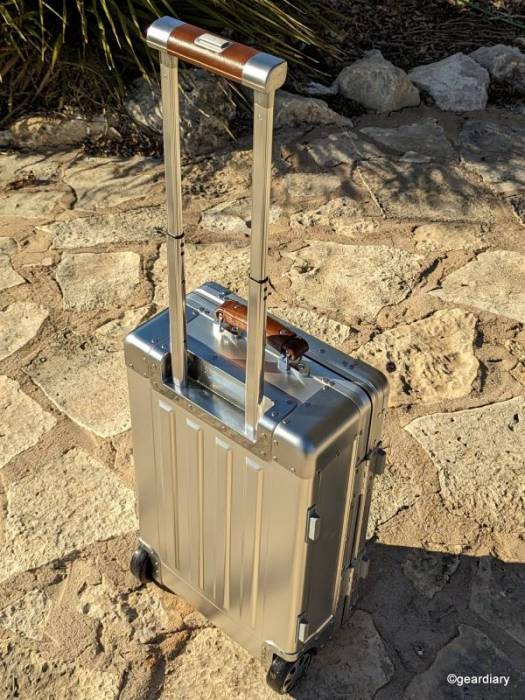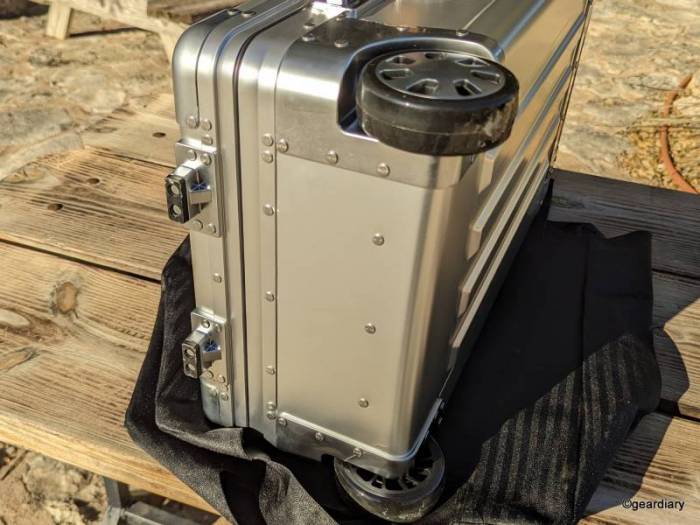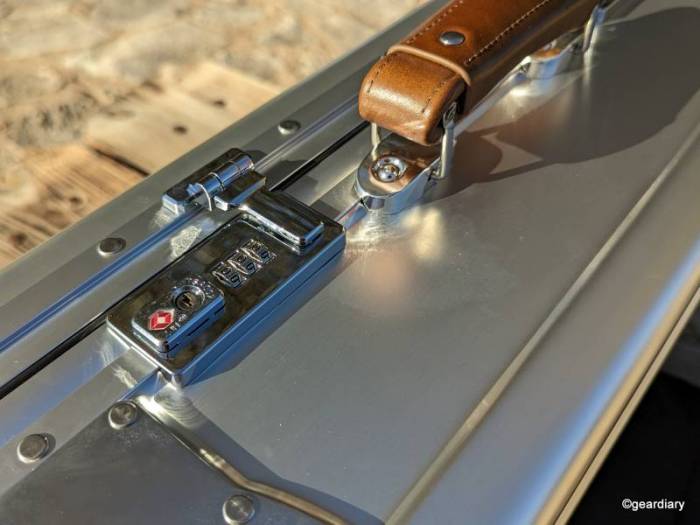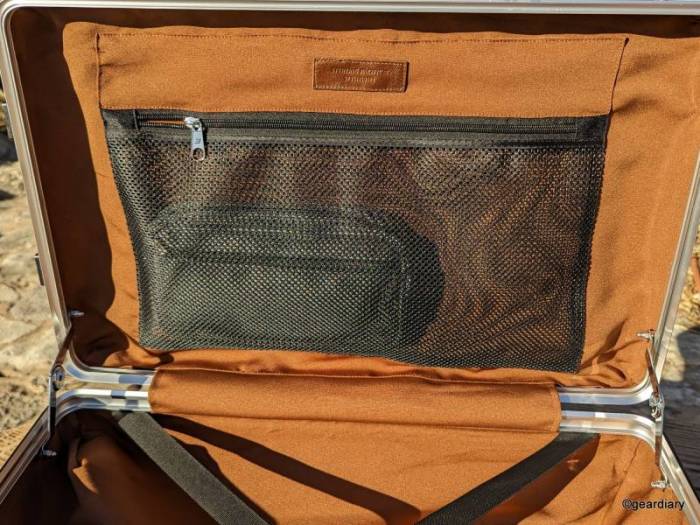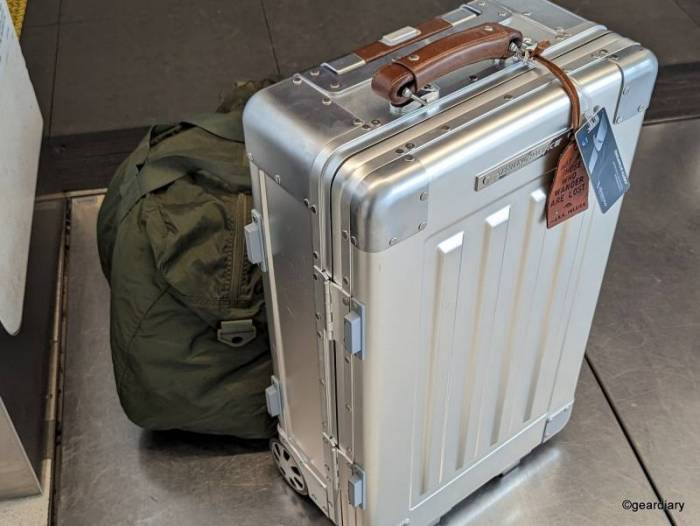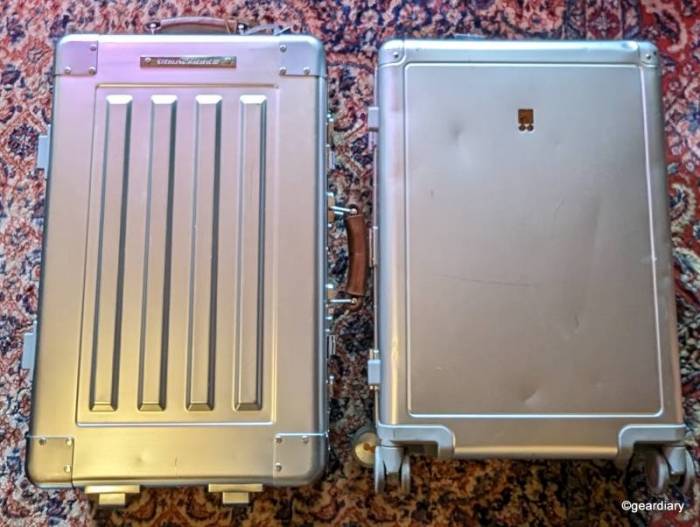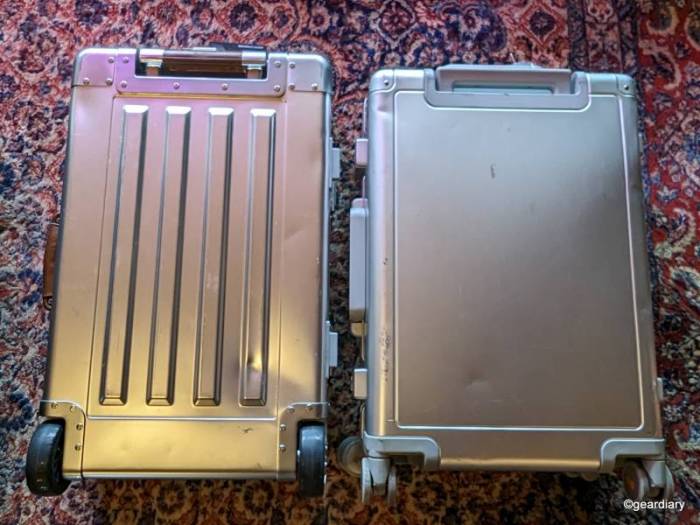The Lowdown
The Sterling Pacific 35L Cabin Travel Case is one of the most gorgeous and over-engineered aluminum suitcases I have ever used. I love that it’s built like a tank, functions like a trunk, and can travel any terrain with ease; the warranty is the icing on the cake. Frequent travelers who are willing to invest in a statement bag that can handle the rigors of the road are going to love it, as this carry-on’s full aluminum body, leather handles, and chic, retro styling will garner plenty of compliments.
Overall
Pros
- 100% aluminum construction in a retro design with reinforced corners, wheel wells, and trolly area
- Full leather top and side handles
- TSA-approved latch locks
- Trunk-style set-up inside
- Roomy interior with enough space to pack a week or more’s clothing
- Extra security and weather-proofing for your stuff
- Zippered mesh pocket on the lid
- Included amenity kit
- The telescoping trolley handle has multiple levels so it will work for users of any height
- Beefy dual thru-axle wheels Limited lifetime warranty and an excellent lifetime service promise
Cons
- It’s expensive
Business travel is ramping back to pre-pandemic levels, which means many of us are once again on the road or in the air multiple times a month. If the sight of your beat-up carry-on is making you question its viability, the Sterling Pacific 35L Cabin Travel Case is here for your consideration. Built like a tank and sporting a chic retro style, this bag harkens to an era when travel was an event. It costs as much (or more) than a round-trip economy flight to Europe, but could this bag be the last you’ll ever have to buy?
Aluminum carry-ons stand out from their cloth and polycarbonate cousins for a reason: when done right, they are stylish and functional.
Some of the reasons why aluminum luggage can be a great choice include the following:
• Weather-proofing: Quality aluminum luggage closes with compression locks or latch locks once the hard outer lip on one side of the bag has overlapped the inner lip of the bag’s other side as they come together for closure. There is no exterior zipper to allow leakage when you or your luggage are caught in the rain, and this is a good thing.
• Efficient Packing: Although even basic aluminum carry-ons can hold more than you think, due to their hard sides and their lock’s lack of give, aluminum luggage simply can’t be overstuffed. You will be forced to make packing decisions that will ensure that you have exactly what you need and aren’t over-packing.
• No exterior zippers means better theft deterrence: Sure, someone can always snatch and grab your luggage, but that’s not the only way you can lose a bag’s contents. A cloth suitcase can be slashed open. Polycarbonate luggage fares a bit better in this scenario, but the fabric zipper line is still a vulnerable entry point; the cloth above or below the zipper can be slashed, or a thief can push a ballpoint pen into the zipper allowing access to your stuff. None of this is possible with an aluminum suitcase that uses compression or latch locks.
• Better protection for your breakable items: If you regularly travel with breakable items, hard-shell luggage offers crush protection that can’t be matched — just make sure that your packed items are properly cushioned inside.
• It’s durable: Cloth luggage can fray and wear on stress points, and polycarbonate luggage can crack. Even though aluminum luggage will develop travel scars, the components will hold up and still be serviceable for many years —unless the luggage is crushed or severely abused.
• It’s beautiful: Aluminum luggage is eye-catching, whether it is new and pristine or whether it has been beaten up and covered in stickers. The superficial dents, scrapes, scratches, and dings — travel scars, if you will — give the bag a patina that tells your well-traveled story without you having to say a word.
If you’re a frequent traveler, the investment in aluminum luggage can be well worth the return when you consider all of the benefits.
Even so, there are a few reasons why you might not want to invest in full aluminum luggage.
- When empty, aluminum luggage can be slightly heavier than a similarly sized polycarbonate or cloth carry-on, so you’ll need to keep that in mind if you aren’t able to lift a total of 30 pounds or so when it’s time to lift your bag into the overhead bin.
- You won’t necessarily be able to stuff that “one last thing” into an aluminum suitcase.
- If you can’t stand seeing dents or scratches on your luggage, aluminum isn’t for you.
- Aluminum luggage can be a costly investment.
In the US, a rough standard when considering carry-on luggage is that it should be around 22″ long by 14″ wide by 9″ thick, but some regional jets will make you gate-check your bag if it isn’t the size of a backpack.
It’s also worth mentioning that there are no hard and fast size limits for international travel carry-ons. Some international carriers will allow a slightly larger carry-on, but others will make you check your bag if it exceeds their particular size standards.
So let’s look at the sizes, weights, prices, and warranty lengths of several popular brands’ full aluminum carry-ons.
I’ve marked the carry-ons that are the lightest, have the largest exterior size (including the wheels), and the ones with the most extended warranties in bold. The most expensive aluminum carry-on, the heaviest, the shortest warranty, and the smallest exterior size (including the wheels) are noted in italics.
- The 2-wheel Sterling Pacific 35L Cabin Travel Case measures 22.5″ by 14″ by 8.5, and it weighs 11.5 pounds; it sells for $1950. This bag comes with a lifetime limited warranty and an impressive service promise that I’ll touch on further in this review.
- A similarly-sized 2-wheel Zero Halliburton Classic Aluminum Two-Wheel Carry-On measures 21″ by 14″ by 9″; it weighs 11 pounds and sells for $665. This bag comes with a five-year limited warranty.
- A similarly sized 4-wheel Rimowa Classic Cabin measures 21.7″ by 15.8″ by 9.1″; it weighs 9.5 pounds and sells for $1525. This bag comes with a 5-year limited warranty.
- A slightly smaller 4-wheel Zero Halliburton Continental Carry-on Case measures 21″ by 14″ by 9″; it weighs 12.5 pounds and sells for $1095. This bag comes with a 5-year limited warranty.
- A similarly sized 4-wheel 20″ LEVEL8 Gibraltar Full Aluminum Carry-On measures 22″ by 15″ by 8.5″. It weighs 10.14 pounds and sells for $429.99. This bag comes with a lifetime limited warranty.
- A slightly smaller 4-wheel MVST TREK Aluminum carry-on measures 22″ by 14″ by 8.7″; it weighs 9.6 pounds and sells for $395. This bag has a 5-year limited warranty.
- A slightly smaller 4-wheel AWAY Aluminum Edition Carry-On measures 21.5″ by 13.5″ by 9″; it weighs 10.7 pounds and sells for $725. This bag comes with a lifetime limited warranty.
- A slightly larger 4-wheel Arlo Sky The Frame Carry-On Max: Aluminum Edition measures 23.0″ by 15.0″ by 9.6″; It weighs 10.5 pounds and sells for $695. This bag has a 5-year limited warranty.
I’ve owned Rimowa, Zero Halliburton, and LEVEL8 carry-on bags; of them all (and the others on this list), the Sterling Pacific stands out as being the most expensive.
It would be fair to wonder what could possibly justify paying $1950 for a 35L Cabin Travel Case when there are other seemingly excellent options available for literally less than half its price.
Well, let’s dig in and see.
The Sterling Pacific 35L Cabin Travel Case Features Include:
- Full 5052 aluminum body with impact-bearing ridges
- Reinforced A380 aluminum corners
- A380 aluminum wheel housings
- A380 aluminum trolley housing (no plastic!)
- A retractable, two-bar aluminum trolley
- Italian full-grain leather handles
- Extruded 6063 aluminum frame
- Dual thru axle wheels
- TSA double combination latch locks
The Sterling Pacific 35L Cabin Travel Case ships in a recyclable cardboard box with inflated, recyclable plastic corner reinforcements; the suitcase comes wrapped in a reusable branded cloth storage bag that slips over the top and velcro’s shut on the bottom.
The 35L Cabin Travel Case has a full 5052 aluminum body with die-cast A380 aluminum used on the corners, wheel housings, trolley housing, and trolley handle. Holding everything in place are more than one hundred SAE 304 stainless rivets that “have a shearing force of 26,000 pounds of weight per square inch.”
While the type of aluminum used might not be something you’d usually give a second thought to, Sterling Pacific notes that 5052 aluminum “is used in the aviation industry due to its high strength-to-weight ratio, corrosion resistance, and formability.”
There are full-grain Italian aniline leather handles on top and right side of the bag. The leather is from an independent tannery based in Chiampo, a small town in the Italian Veneto region. Sterling Pacific notes that Italian aniline full-grain leather is the most durable grade of leather used in long-lasting upholstery and that it contains the entire grain layer of the cowhide with its natural imperfections and marks. Rather than wear out over time, it will develop a natural patina.
Honestly, what you and anyone else who sees you using this bag are going to notice is that the Sterling Pacific 35L Cabin Travel Case is absolutely gorgeous. The juxtaposition of the matte silver aluminum impact-bearing ridges with the chromed Sterling Pacific badge and the two chocolate leather handles is a total chef’s kiss.
Straddling the right side’s leather handle are two TSA-approved, spring-loaded latch locks that can be set with the same three-digit passcode or two separate passcodes. The following photo might be the first time that you notice that the 35L Cabin doesn’t use the typical 50/50 clamshell design of many carry-ons.
Instead, this bag takes a functional cue from one of my favorite types of luggage, the trunk. The Sterling Pacific 35L Cabin Travel Case pairs a roughly 5.75″ deep main section with a 1.5″ deep lid section, making this bag perfect for propping on a luggage stand for living out of when you’re on the road.
This is also where we get our first glimpse at the recessed rear wheels.
Please allow me a moment to digress.
The Case for a 2-Wheeled Upright Luggage
4-wheel spinner bags are very popular, and I enjoy using them. I’ve also had great experiences with 2-wheeled carry-ons, which are pulled behind you with your arm extended and your wrist turned so that your hand is backward-facing while wrapped around the extending trolly handle. I’ll be the first to admit that 2-wheels aren’t quite as easy to maneuver in an airport because the bag must be pulled behind you rather than rolling at your side.
Even so, I’ve found a new appreciation for 2-wheeled luggage as I’ve traveled extensively with the Sterling Pacific for the past month or so. During that time, I have been on several weekend car trips as well as multiple domestic and international flights with this bag.
Upright, 2-wheel carry-on bags generally have oversized, recessed wheels that are better able to handle harsh impacts — whether they be from baggage handers or the shock of being run across rough surfaces — than their 4-wheeled spinner counterparts.
The Sterling Pacific 35L Cabin Travel Case has two beefy 3.5″ long by 1.25″ roller-blade-type through-axel wheels mounted inside the rear 2.5″ tall by 2.5″ wide by 1.5″ deep wheel wells.
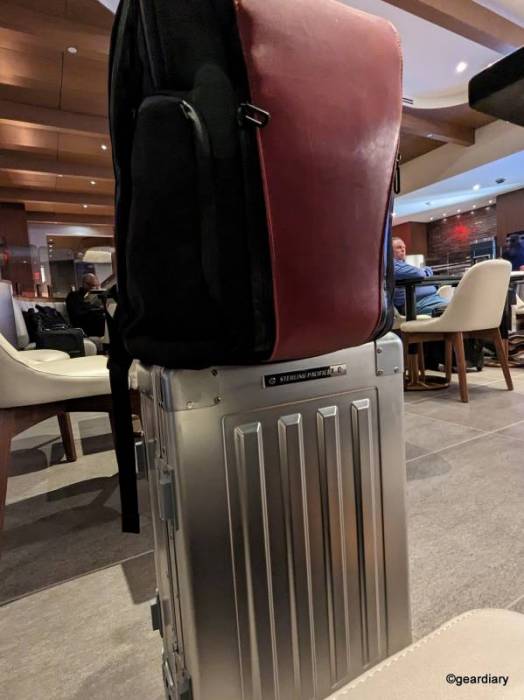
If you have a bag or backpack that has a trolley handle slot on it, you can slip your bag over the handle, but if your bag doesn’t offer that, you can fasten just about anything to this bag by using an add-a-bag strap a J hook strap, or an expandable luggage strap.
I find that a 2-wheeled bag is easier to roll in a straight line, as it is pulled behind you, and I appreciate that unlike a 4-wheeled bag, a 2-wheeled bag won’t can’t randomly start rolling away from you any time it’s set on a bit of an incline.
My experience has been that it’s easier to get a 2-wheeled bag placed in an airline’s overhead bin, as I can put it in wheels first, and the bag just slides into where it’s supposed to be on those big rubbery wheels.
I should mention that the two wheels on the Sterling Pacific extend about 1.5″ from the suitcase’s wheel wells, whereas the spinner wheels on the LEVEL8 Gibraltar extend by 2.25″, as do the spindly wheels on my 21″ polycarbonate Rimowa Salsa Deluxe Cabin Mutiwheel (that style is retired, but this model is similar).
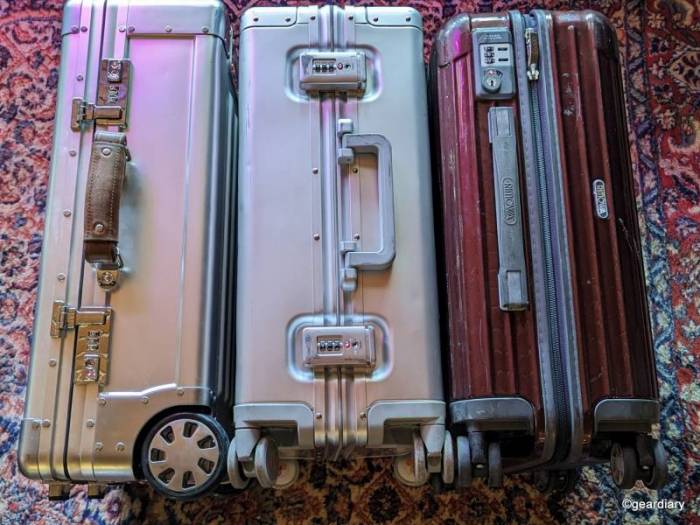
The Sterling Pacific 35L Cabin Travel Case vs. LEVEL8 Gibraltar vs. Rimowa Salsa Deluxe Cabin Mutiwheel
I’ve also learned (the hard way) that a 2-wheeled carry-on is easier to safely situate on escalators, as I only need to worry about the two stops on the bottom front of the bag resting on the escalator if the carry-on is on the step ahead of me, or I’ll ensure that the two rear wheels are on the escalator if the bag is on the step behind me.
Yes, there’s a story there. Be patient.
The Case for 4-Wheeled Spinner Luggage
Check out this guy as he displays the classic “I’ve got a 4-wheeled spinner” nonchalance. Trust me; I can fully respect the situational perfection of that type of luggage.
Any traveler who’s ever used a 4-wheel spinner knows that there’s no better way to maneuver through an airport than with one; there’s an effortless feeling that can only be achieved when your hand is resting on a spinner’s handle as it practically rolls itself down one smooth surface after another.
Adding to the convenience is how you can also push a 4-wheel spinner sideways in front of you, which offers easy navigation through those narrow economy-class aisles.
Any two-wheeled bag user will agree that airline aisles tend to get a bit narrower outside of the premium classes, and if you’re pulling a carry-on behind you and not paying attention, it’s common to hang a two-wheeled bag on one of the seats that you’re trying to pass.
It’s easy to feel a tiny bit smug when you’re rocking a spinner over smooth surfaces as you see others pulling their bags behind them less gracefully. But four wheels aren’t always the best solution.
The Case Against 4-Wheeled Spinner Luggage
Whether coming or going, unless you’re regularly picked up at the door, chauffeured to the next destination, and then actually dropped off at the most convenient delivery spot available, there are going to be plenty of treacherous and unforgiving surfaces that you’ll have to roll your 4-wheel bag over.
Here are just a few of the numerous snafus that I’ve witnessed over the years when 4-wheel spinner bags weren’t necessarily the better option outside of the airport or hotel.
4-Wheel Luggage Fail #1 – European Cobblestones

An example of some of the cobblestones you might encounter when staying in a European historical district.
It was supposed to be a 10-minute walk from the European train station to our “it’s so close that we won’t need to get a taxi” rental. But we hadn’t taken into consideration that my colleague would have to lug her 4-wheel spinner bag over multiple long blocks of cobblestones.
A few feet onto the uneven terrain was all it took for her 4-wheel spinner to be switched into a 2-wheel upright that she was now tugging behind her — the proper method in such a situation as a 2-wheeled bag gives a better-leveraged pull.
The issue, however, was that while her small spinner wheels were able to tilt and roll when needed, they weren’t beefy enough to handle the beating that the cobblestones were giving them.
It wasn’t long before one of her bag’s rear wheels snapped off while we were still several blocks away from our destination; We could reinsert the stem of the wheel into its holder, but the wheel wouldn’t stay in place as whatever had held it there was now broken.
We had to half-carry and half-roll her luggage between us while also dragging my bag. Good times.
4-Wheel Luggage Fail #2 – Escalators
Then there was that time when I made a miscalculation on where I could safely perch my brand-new aluminum Rimowa 4-wheel carry-on while ascending an escalator at the Barcelona airport. I will absolutely own up to the fact that I was distractedly talking to a colleague as we boarded the escalator, and I may not have been paying complete attention to how far out the rising steps extended as they popped out above me.
I noticed that the rising escalator step was starting to protrude into my suitcase a bit more than I had estimated. As I tried to shuffle my bag back on its perch just a smidge, the still-extending step somehow snapped off one of the bag’s spinner wheels. My hand was on the extended trolly handle, and I didn’t let go in time. It happened so fast, and yet I remember it in slow motion.
Thankfully, I wasn’t too far up on the escalator, but it was still a decent tumble when my bag and I fell head over heels to the bottom.
I was wearing a dress, I might add, and a Burberry trench coat. I managed to break the skin on one of my elbows, bloodying the inside of the coat; thankfully, the sleeve didn’t tear!
I’ll spare you the bloody photos (oh yeah, I have them for posterity), but needless to say, I was impressed by the Burberry coat. The Rimowa aluminum carry-on? Not so much. Thankfully, I was able to return it once I got home without much of a hassle.
I should mention that I’ve never had another issue with a spinner carry-on on any escalator, but that’s probably because I’m now so paranoid about taking another tumble that I pay a ridiculous amount of attention to exactly where any bag’s wheels are set. I don’t catch myself being as obsessive when I’m using 2-wheeled luggage on an escalator.
4-Wheel Luggage Fail #3 – Sloped People Movers
There are quite a few airports around the world that have steep enough people movers that if you don’t place your 4-wheel spinner bag behind you when descending (or in front of you when ascending), your heavy bag can actually break away from you and flatten anyone in gravity’s path.
I have stood on these step-less escalators many times, convinced that my heavily packed spinner was about to become the world’s most treacherous bowling ball, even with it placed behind me! This is something I’ve never had to worry about when using two-wheeled luggage; I just turn the bag to its side while holding the trolly handle, and it rides solidly next to me.
So Which Is Better?
The main thing before deciding whether you’d get better use out of a 2-wheeled upright or a 4-wheeled spinner is to think about what kind of terrain you’ll likely encounter during your trips based on past experiences. If you know in advance that you’ll only be rolling your carry-on through the airport, to your ride, and into the hotel, a 4-wheeled bag is a great choice.
But if, based on past experience, you know you’ll have to deal with hazards, slopes, or uneven terrain, a 2-wheeled bag might just be the better choice.
Back to the Review!
On the back of the Sterling Pacific 35L Cabin Travel Case, you can see the industrial design language of layered aluminum and stainless steel rivets continuing around the corners and the leather-wrapped trolley handle.
On the left side of the bag, there are two hinges and four hard feet; Sterling Pacific is engraved into the bag as well as the Batch Identification Number (BIN), which identifies the makes, the bag’s volume in liters, years since founding, the batch number for the year, and the year of manufacturing.
There will also be three to five additional digits in the BIN that will help the brand identify the bag should you ever need service.
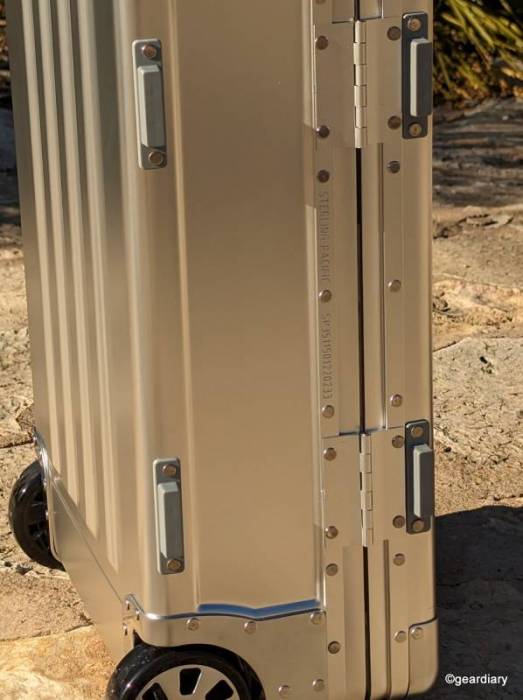
Sterling Pacific says there are over 100 stainless steel rivets used in this bag’s construction; I did a quick count and spotted at least 120!
Here’s the top of the bag, showing the leather handle and the leather-wrapped aluminum trolley handle.
Worth mentioning is that the retractable trolly handle and its housing are all made of aluminum. You may have noticed in your other bags that trolly housing is typically made from plastic.
Because the double bar aluminum trolly handle has a high-fatigue strength, the company says that it won’t bend with up to 110 pounds of pressure on it, and it won’t collapse with up to 132 pounds of pressure on it.
Pressing the button in the middle of the trolly handle allows it to extend to locked positions at 5.5, 12.5, 15.5, and 19.5″.
The trolley handle is collapsed by pressing and holding the button.
Here’s a look at the stoppers on the bottom front of the Sterling Pacific 35L Cabin Travel Case; they are made of aluminum with a thick polycarbonate cap that is riveted on.
This bag has two double spring-loaded TSA-approved combination latch locks; it ships 0-0-0 set as code, so you’ll want to change that before traveling.
To change the lock code, you’ll open the lock and then spin the external three-digit dial to your chosen numbers, and then you’ll repeat it on the other lock using the same or a different code (for added security).
The Sterling Pacific latch locks work well, but I like the compression locks on the LEVEL8 bag better.
Inside the Sterling Pacific 35L Cabin Travel Case
Lining the bag’s interior is a ring-spun twill weave lining in golden brown. On the shallower top portion of the clamshell case, there is a leather badge embossed with the Sterling Pacific name and the BIN. Directly under is an approximately 16.5″ wide by 9.5″ deep zippered pocket with a metal Sterling Pacific pull.
On the deeper side of the suitcase, there are four adjustable nylon straps with metal hardware and two sets of metal buckles.
These straps manage to offer a surprising amount of compression without taking up as much room as the metal-reinforced mesh and Velcro compression panels that Rimowa, LEVEL8, Zero Halliburton, MVST, AWAY, and Arlo Skye use, which seems to free up a little bit of room.
I like that I can pack my necessary clothing and a pair of shoes in the case using bundling or clothing cubes; once everything is strapped down, I still have room for deodorant, the included amenity bag, a packable nylon duffle bag that I never travel without, and some other loose items into the zippered mesh bag.
Each Sterling Pacific travel case comes with an amenity & care kit, which holds branded items, including a 9″ long by 5″ wide by 1.5″ deep dopp kit, a 1-ounce leather care wax & microfiber cloth, an aluminum pen, and a user manual.
While I appreciate the bit of swag, I would have much preferred it if Sterling Pacific had included a leather luggage tag instead of the skinny dopp kit or the aluminum pen, but alas.
Since receiving the Sterling Pacific 35L Cabin Travel Case for review, I’ve used it for several weekend car trips, as well as multiple domestic and international flights.
The bag is roomy enough that it is easy to pack three or four changes of clothes, a couple of pairs of shoes, and whatever toiletries might be needed for a weekend away without having to really think about what I’m doing.
It might seem impossible, but with a little bit of planning, you can easily pack this carry-on with enough fresh clothing to last for a week or more and a second pair of shoes.
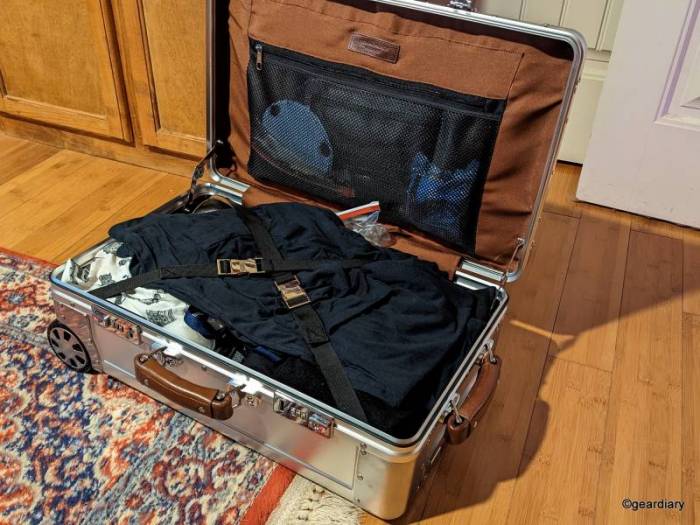
The Sterling Pacific 35 L Cabin is packed with a week’s worth of business clothing, an extra pair of shoes, and non-liquid toiletries for MWC in Barcelona. I carried my liquids and electronics in my WaterField Pro Executive Backpack.
If you’re unsure about how to pack a carry-on efficiently, there are two methods that can make a huge difference: using compression packing cubes, as shown in this video …
… or using the bundling method, as shown in this video.
Are you someone who always seems to come home with more than you left with? That’s me, and that’s why I always travel with a packable nylon duffel bag to hold my dirty clothes, the extra pair of shoes, and other non-crushable items for the trip home.
Doing this frees up room in my carry-on so I can bring back just about anything (within reason) without buying another bag.
On my way back from Barcelona, for instance, I had to check the Sterling Pacific as it was holding several bottles of Spanish wine wrapped in some of my dirty clothes. I would have preferred using this bag as a carry-on, but TSA frowns on trying to get liquids larger than 3 ounces in a quart-sized ziplock through their stations.
That’s all right, though, as I wanted to see how the bag would handle the abuse of being checked, especially on an international flight.
While I knew that it would be reasonable for any aluminum bag to accumulate some scrapes and dings after being checked on an international flight, I was also curious about whether the Sterling Pacific bag would show any real damage.
Considering that the LEVEL8 Gibraltar that I’ve been using for the past year has seen plenty of checked travel and, in the process, has picked up its share of superficial scrapes, dents, and dings, I was interested to see how the Sterling Pacific would fare.
Well, oddly enough, on its maiden international return voyage, the Sterling Pacific 35L Cabin Travel Case only picked up a couple of dings and minor scrapes. I think that luck lulled me into a false sense of laissez-faire, though.
On my next series of domestic flights, I threw caution to the wind and checked the bag on my way home each time, resulting in several more scrapes and an annoying series of cosmetic dents and dings on the bag’s backside.
It’s all cosmetic, and in my opinion, it adds to the bag’s patina. Even so, this is something you’ll want to be aware of if you decide to buy any aluminum luggage — every time you check it; it will likely come back with a bit of (hopefully) minor damage.
Since both bags are similarly traveled now, I thought it would be fun to look at the front and back of the Sterling Pacific and the LEVEL8 carry-ons just to compare travel scars.
There are some superficial scrapes and dings on both the front of the Sterling Pacific, but otherwise, it’s relatively unscathed. The LEVEL8, however, has some superficial dents and deeper scrapes across the front, but I don’t think that makes it look bad at all.
The amount of damage on the edges of the LEVEL8 is disappointing, but it’s truly superficial.
As mentioned, on my last domestic flight home, I picked up more damage than usual in the form of a larger (although still superficial) dent and some smaller dings and scrapes on the Sterling Pacific’s back. The dent near the bottom looks pretty vicious, but it’s cosmetic.
Meanwhile, the LEVEL8’s back is relatively dent-free, minus the dimpling around all of the bag’s edges. Again, this damage is all superficial, but it just goes to show some of the abuse that our bags go through when they get checked.
Remember, part of the fun of owning an aluminum bag is collecting travel scars. As long as they don’t affect the bag’s integrity, they just give the bag character.
Okay. I know I just dropped a lot on you, but before I wrap this up, we need to chat about the warranty Sterling Pacific offers on their luggage; if you’re considering buying 2-wheeled aluminum luggage, it could be the deciding factor …
Sterling Pacific not only has a lifetime warranty, but they also have a “service promise.”
The lifetime warranty “covers manufacturing defects and the main functionality of the travel case for the entire life of the travel case.” As you’d expect, the lifetime warranty & service promise doesn’t “cover any type of cosmetic damage (eg. dents, scuffs, scratches or cracks), misuse or abuse, damages or negligence caused by any third party, particularly airlines or travel operators.”
They also recommend that you “inspect your travel case at the airport after each flight and immediately report any damage to the carrier who is insured against such damage.” [Duly noted]
But here’s where their service promise kicks in, and this is a really cool example of customer service long after a sale and beyond an excellent warranty:
Sterling Pacific offers a complimentary supply of spare parts (eg. leather handles, locks) for simple screwdriver self-repairs for life. More complicated repairs may require customers to send the travel case to Sterling Pacific’s service center at 3515 Airway Dr in Reno, NV, or our staff might assist you to find a local solution for a repair. In some situations, Sterling Pacific might offer a replacement unit for your travel case instead.
So is it worth buying the Sterling Pacific 35L Cabin Travel Case at $1950?
The answer is yes, if you love the retro style, are intrigued by the materials and craftsmanship, prefer a 2-wheeled carry-on, and are a frequent enough traveler that the warranty and service promise perked your ears. Otherwise, I’ve mentioned enough other prospects in this review that you might have spotted a possible alternative.
The Sterling Pacific 35L Cabin Travel Case is one of the most gorgeous and over-engineered aluminum suitcases I have ever used. I love that it’s built like a tank, functions like a trunk, and can travel any terrain with ease; the warranty is the icing on the cake. Frequent travelers who are willing to invest in a statement bag that can handle the rigors of the road are going to love it, as this carry-on’s full aluminum body, leather handles, and chic, retro styling will garner plenty of compliments.
The Sterling Pacific 35L Cabin Travel Case retails for $1950; it is available directly from the manufacturer and other retailers, including Amazon. Worth noting is that the brand offers a 25% discount on all licensed pilot and airline crew orders.
Source: Manufacturer supplied review sample
What I Like: 100% aluminum construction in a retro design with reinforced corners, wheel wells, and trolly area; Full leather top and side handles; TSA-approved latch locks; Trunk-style set-up inside; Roomy interior with enough space to pack a week or more’s clothing; Extra security and weather-proofing for your stuff; Zippered mesh pocket on the lid; Included amenity kit; The telescoping trolley handle has multiple levels, so it will work for users of any height; Beefy dual thru-axle wheels Limited lifetime warranty and an excellent lifetime service promise
What Needs Improvement: It’s expensive

